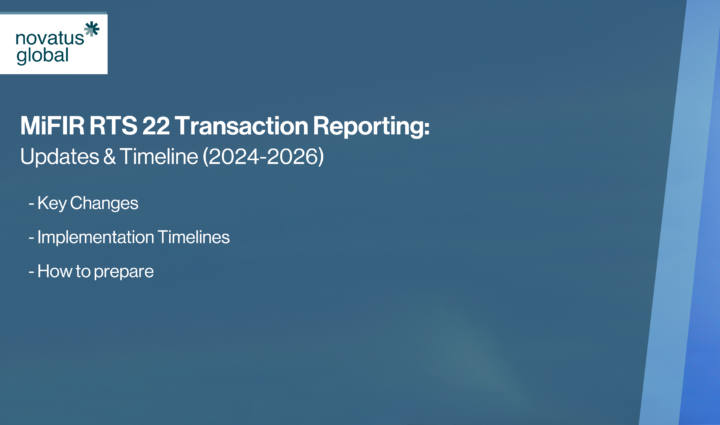
MiFIR RTS 22 Transaction Reporting Updates & Timeline (2024-2026)
The European Securities and Markets Authority (ESMA) is progressing with its comprehensive review of MiFID II and MiFIR, introducing significant updates to the MiFIR Regulatory Technical Standards (RTS) 22 framework for transaction reporting. This review, a critical part of ESMA’s commitment to enhancing regulatory efficiency and data quality, is designed to align reporting obligations with evolving market practices and other financial regulations such as EMIR Refit and MiCA.
Following the release of a Consultation Paper (CP) on 3 October 2024, ESMA has set a timeline for industry feedback by the 3rd of January 2025. The issuance of the Final Report of the RTS update is expected to be in Q1 of 2025. Firms should prepare for the go-live of MiFIR RTS 22 changes, expected in Q1 2026, by understanding the proposed revisions and their potential impacts.
Key Changes to MiFIR RTS 22
1. Scope of Reporting
ESMA proposes expanding the scope of products subject to MiFIR RTS 22 reporting. Key updates include:
- Crypto-Asset Derivatives: As the Markets in Crypto-Assets (MiCA) regulation progresses, crypto products traded on trading venues will fall within RTS 22’s reporting requirements. This aligns MiFIR with emerging regulatory standards for digital assets.
2. Alignment with Other Regulations
The revisions aim to harmonise MiFIR reporting with EMIR Refit and SFTR, ensuring consistency in field definitions and data standards. This alignment addresses long-standing industry concerns over discrepancies between overlapping regulatory requirements.
3. Field Adjustments
The CP outlines several changes to transaction reporting fields, including the addition of new fields, updates to existing ones, and the removal of outdated elements.
- New Fields:
-
-
- Effective Date/Reporting Timestamps: Harmonises reporting timelines with EMIR Refit.
- Trading Venue Transaction Identification Code (TVTIC): Introduced for transactions on non-EEA venues.
- Token Identifiers: Prepares for digital asset reporting under MiCA.
- Aggregated Order Identifiers: Adds fields to identify chains of aggregated orders, akin to EMIR’s Package Identifier Code.
- Client Identifiers: Enhances clarity around counterparties, particularly non-entity clients.
-
-
- Amendments to Existing Fields: Minor adjustments to fields such as Net Amount, Buyer/Seller, and Executing Entity are proposed to improve consistency with other frameworks. New values will be introduced while maintaining compatibility with existing reporting formats.
- Removed Fields:
-
-
- The Short Selling Indicator is slated for removal, as it is deemed redundant.
-
-
MiFIR RTS 22 Implementation Timeline – Key Dates
- 3 January 2025: Deadline for feedback on ESMA’s Consultation Paper.
- Q1 2025: Final Report and updated technical standards expected.
- Q1 2026: Anticipated go-live for the revised MiFIR RTS 22 framework, providing firms with a 12-month implementation period.
Challenges for Firms Posed by the MiFIR RTS 22 Updates
The MiFIR RTS 22 updates present a range of challenges for financial institutions, including:
- System Upgrades: Firms must adapt IT systems to accommodate new fields and align with updated values.
- Data Consistency: Enhanced validation rules necessitate stricter data accuracy and reconciliation processes.
- Cross-Regulation Compliance: The need to synchronise MiFIR reporting with EMIR Refit and future MiCA requirements adds complexity.
- Potential UK-EU Divergence: The UK’s Financial Conduct Authority (FCA) is conducting its own review of MiFID II/MiFIR reporting, which could lead to divergence between UK and EU reporting standards, complicating compliance for firms operating in both jurisdictions.
How Firms Can Prepare for MiFIR RTS 22 Reporting Updates
To remain compliant and mitigate the risks associated with these changes, firms should:
1. Conduct a thorough assessment of current reporting capabilities to identify gaps.
2. Monitor ESMA’s updates closely, especially the Final Report expected in early 2025.
3. Engage with industry groups to stay informed about feedback trends and implementation best practices.
4. Stay vigilant regarding the FCA’s regulatory developments to ensure seamless UK-EU compliance.
Conclusion: Preparing for MiFIR RTS 22 Compliance in 2024-2026
ESMA’s proposed changes to MiFIR RTS 22 mark a significant step forward in refining transaction reporting requirements, with a strong focus on harmonisation and future-proofing for emerging asset classes like crypto-assets. While the changes promise greater consistency and improved data quality, they also demand considerable effort from firms to update systems and processes.
Proactively preparing for these updates is essential. With our expertise in regulatory compliance and state-of-the-art solutions, Novatus Global can help your firm navigate these changes and ensure seamless adherence to the revised RTS 22 standards.
Contact us today to learn how Novatus Global can strengthen and support your regulatory implementation to ensure regulatory success.












